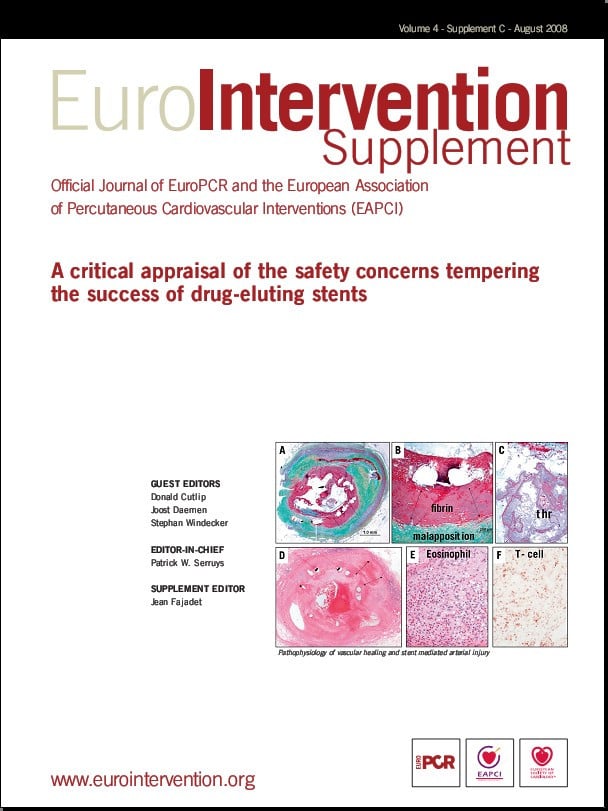Abstract from the STENT registry
Abstract
Objectives: The purpose of this study was to compare the 9-month clinical outcomes of patients treated with paclitaxel-eluting stents (PES) or sirolimus-eluting stents (SES) for coronary artery stenosis.
Background: The STENT (Strategic Transcatheter Evaluation of New Therapies) registry is the first multicenter registry in the U.S. to collect long-term outcomes of drug-eluting stents from “real-world” practice.
Methods: Data on all percutaneous coronary interventions in 8 U.S. hospital centers were collected in the STENT registry between 2003 and 2005. In this prospective, nonrandomized, observational study, the choice of procedures was at the physicians’ discretion. Patients who only received a PES (n=4,671) or SES (n=4,555) and completed 9-month follow-up (93.8% of eligible) were included for analysis. Primary end points were death, myocardial infarction (MI), and target vessel revascularization (TVR) at 9 months. Secondary outcomes included major adverse cardiac events (MACE) (any of the 3 primary end points) and stent thrombosis.
Results: At 9 months, death, MI, and TVR occurred in 2.2%, 2.0%, and 4.1%, respectively, of the PES group and 2.5%, 2.2%, and 4.3%, respectively, of the SES group (p=NS); MACE occurred in 7.5% of the PES group and 8.0% of the SES group (p=0.37). After adjustments for group differences in baseline characteristics, TVR (hazard ratio [HR] 0.88, 95% confidence interval [CI] 0.70 to 1.32; p=0.26) and MACE (HR 0.95, 95% CI 0.81 to 1.12; p=0.56) were similar for PES and SES. Stent thrombosis at 9 months occurred in 0.7% of both groups.
Conclusions: The results of this study show that clinical restenosis and MACE events after PES and SES procedures in “real-world” patients are infrequent and similar at 9 months.
Reference
Acknowledgement
Reprinted from the Journal of the American College of Cardiology Volume 50, Issue 13, 25 September 2007, Page 1214 with permission from Elsevier.
Commentary on the STENT registry
The STENT Registry was an interesting prospective multicentre observational study offering a comprehensive comparison on the midterm safety and efficacy of percutaneous coronary intervention (PCI) with sirolimus-eluting stents versus paclitaxel-eluting stents. It included as many as 9,226 patients finding that both stents lead to similarly high rates of acute success (98.0% in both groups), as well as similarly low rates of 9-month major adverse cardiac events (MACE), death, myocardial infarction, target vessel revascularisation, and stent thrombosis.
The patient and procedural characteristics were typical of U.S. practice, including the common use of glycoprotein IIb/IIIa inhibitors (58.3% in the sirolimus-eluting stent group versus 56.8% in the paclitaxel-eluting stent group) and the adoption of bivalirudin as anticoagulant (respectively 32.4% versus 25.3%). Whereas use of sirolimus- and paclitaxel-eluting stents in the overall sample and in most subgroups was associated with similar rates of adverse events, a notable exception were the subgroups of patients with previous coronary artery bypass grafting or PCI in a saphenous vein graft (SVG). In these subjects, paclitaxel-eluting stents lead to significantly fewer MACE, a finding which appears to corroborate other studies questioning the risk-benefit of sirolimus-eluting stents in SVG, but which should be viewed in light of the wide confidence intervals.
Summarising, the main strengths of this study were the prospective design, the large size, the sophisticated statistical analyses exploiting propensity scores, and the low attrition at follow-up, despite inclusive selection. The main weaknesses were conversely the inclusion of many low-risk patients (e.g., left main PCI was performed in only 0.6% of the sirolimus-eluting stent group and 1.1% of the paclitaxel-eluting stent group), which might have been well served by other stents (e.g., bare-metal), the lack of a bare-metal stent control group, angiographic follow-up, or quantitative coronary angiography and, obviously, the fact that stent type was not randomly allocated.
Moreover, the STENT Registry provided favourable and comparable data for both sirolimus- and paclitaxel-eluting stents at a follow-up of only nine months, which is now considered too short to draw definitive conclusions on the risk-benefit profile of a coronary device, and also cannot inform completely on the choice of a specific stent type versus a competitor. Finally, despite careful adjudication of stent thrombosis (occurring cumulatively in 0.7% of patients at nine months), the STENT Registry was conceived and conducted before the Academic Research Consortium efforts. Thus, data on stent thrombosis from this study cannot be directly compared with other more recent clinical trials.
In conclusion, notwithstanding the above limitations, the STENT Registry provided key data on a large and real-life group of patient treated with sirolimus- and paclitaxel-eluting stents, showing that both stents were equally safe and effective at mid-term follow-up in the percutaneous management of coronary artery disease. Long-term follow-up data from this study, which could now reach a median of more than 40 months, are eagerly awaited and will hopeful repeat the satisfactory risk-benefit profile of both stents shown at nine months.

